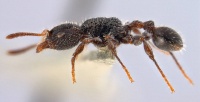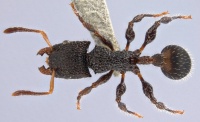Dilobocondyla rugosa
| Dilobocondyla rugosa | |
|---|---|

| |
| Scientific classification | |
| Kingdom: | Animalia |
| Phylum: | Arthropoda |
| Class: | Insecta |
| Order: | Hymenoptera |
| Family: | Formicidae |
| Subfamily: | Myrmicinae |
| Tribe: | Crematogastrini |
| Genus: | Dilobocondyla |
| Species: | D. rugosa |
| Binomial name | |
| Dilobocondyla rugosa Zettel & Bruckner, 2013 | |
Nothing is known about the biology of Dilobocondyla rugosa.
Identification
Zettel and Bruckner (2013) - Worker: Black; scape, distal tarsomeres, and base of gaster yellow. Posterior margin of head concave. Frontal carinae strong, reaching posterior corners of head. Sculpture of head and especially of mesosoma coarse; interspaces on head mostly reticulated, on mesosoma smooth and strongly shiny. Petiole very slender, PtI 196 - 219.
This species shares a bicoloured gaster tergite 1 (with yellow base) with Dilobocondyla carinata, but strongly differs from that species by sculpture and the lack of a transverse ridge on the petiole. Dilobocondyla selebensis from Sulawesi, described from a gyne shares a concave hind margin of the head and strong rugae on its dorsal surface, but it has less developed antennal scrobes, is entirely black and relatively large (TL ca. 6 mm).
Keys including this Species
Distribution
Latitudinal Distribution Pattern
Latitudinal Range: 13.86666667° to 13.86666667°.
| North Temperate |
North Subtropical |
Tropical | South Subtropical |
South Temperate |
- Source: AntMaps
Distribution based on Regional Taxon Lists
Indo-Australian Region: Philippines (type locality).
Distribution based on AntMaps
Distribution based on AntWeb specimens
Check data from AntWeb
Countries Occupied
| Number of countries occupied by this species based on AntWiki Regional Taxon Lists. In general, fewer countries occupied indicates a narrower range, while more countries indicates a more widespread species. |

|
Estimated Abundance
| Relative abundance based on number of AntMaps records per species (this species within the purple bar). Fewer records (to the left) indicates a less abundant/encountered species while more records (to the right) indicates more abundant/encountered species. |

|
Biology
Castes
Known only from the worker caste.
Nomenclature
The following information is derived from Barry Bolton's Online Catalogue of the Ants of the World.
- rugosa. Dilobocondyla rugosa Zettel & Bruckner, 2013: 144, figs. 3, 9, 15 (w.) PHILIPPINES (Luzon I.).
- Type-material: holotype worker, 4 paratype workers.
- Type-locality: holotype Philippines: Luzon, Camarines Sur, Lupi, Sooc, 29.ii.2004, no. P47 (C. Pangantihon); paratypes: 3 workers with same data, 1 worker Luzon, Camarines Sur, Lupi, Sooc, Looban, 15.iii.2004, no. 381 (H. Zettel).
- Type-depositories: USCC (holotype); HSZC, NHMW (paratypes).
- Status as species: Chen, et al. 2019: 138 (in key).
- Distribution: Philippines (Luzon).
Unless otherwise noted the text for the remainder of this section is reported from the publication that includes the original description.
Description
Worker
Holotype: TL 3.98; HW 1.02; HL 1.10; CI 93; SL 0.65; SI 64; PnW 0.76; PtL 0.42; PtH 0.20; PtW 0.21; PtI 210; PpL 0.31; PpH 0.31; PpW 0.32. Paratypes: (1) TL 4.20; HW 1.06; HL 1.14; CI 93; SL 0.65; SI 61; PnW 0.80; PtL 0.45; PtH 0.22; PtW 0.22; PtI 205; PpL 0.32; PpH 0.33; PpW 0.33. (2) TL 4.34; HW 1.09; HL 1.18; CI 92; SL 0.69; SI 63; PnW 0.82; PtL 0.46; PtH 0.22; PtW 0.24; PtI 209; PpL 0.34; PpH 0.34; PpW 0.34. (3) TL 4.15; HW 1.05; HL 1.12; CI 94; SL 0.67; SI 64; PnW 0.79; PtL 0.46; PtH 0.21; PtW 0.21; PtI 219; PpL 0.31; PpH 0.32; PpW 0.32. (4) TL 4.20; HW 1.07; HL 1.16; CI 92; SL 0.67; SI 63; PnW 0.81; PtL 0.45; PtH 0.23; PtW 0.22; PtI 196; PpL 0.34; PpH 0.34; PpW 0.35.
Colour: Body chiefly black. Mandibles yellowish brown. Antennae dark brown; scape and base of funiculus yellow. Legs brown; trochanters, bases of femora, and distal tarsomeres pale. Gaster tergite 1 with distinct yellow mark at base.
Structures: Head dorsally and on genae with almost regular striation and scarce interconnections, rather reticulated below and behind eyes. Interspaces on dorsum of head usually with distinct micro-reticulation that is only reduced and indistinct near hind margin and medially of frontal carinae. Posterior margin of head concave; hind corners angular. Frontal carinae and antennal scrobes reaching hind corners. Clypeus with three distinct longitudinal rugae (medial one short in small specimens), its surface smooth, at most with traces of a micro-reticulation.
Mesosoma almost entirely with very coarse reticulation; highly elevated rugae forming large polygonic meshes; an imaginary line between pronotal corners transecting nine or ten meshes; mesopleura partly smooth, as shiny as all interspaces. Petiole anterodorsally with fine micro-reticulum; posterodorsally and laterally with coarse irregular rugae, at most with remnants of microsculpture; in lateral view slender, dorsal outline almost evenly convex, anteroventral process spine-like, slender. Postpetiole in lateral aspect distinctly raised, with broadly rounded apex; anterodorsal surface with very fine rugae and distinct micro-reticulation, posterodorsal surface with regular longitudinal rugae and smooth interspaces. Gaster tergite 1 at base with very dense fine striation that gradually changes to a fine reticulum where the yellow mark ends.
Type Material
- Holotype, worker, Luzon Island, Camarines Sur Province, municipality of Lupi, barangay Sooc, ca. 100 m a.sl., Philippines, 13°52′0″N 122°56′0″E / 13.866667°N 122.933333°E, 29 Feb 2004, C. Pangantihon, San Carlos University, Cebu City.
- Paratype, 3 workers, Luzon Island, Camarines Sur Province, municipality of Lupi, barangay Sooc, ca. 100 m a.sl., Philippines, 13°52′0″N 122°56′0″E / 13.866667°N 122.933333°E, 29 February 2004, C. Pangantihon, Natural History Museum Vienna and H. Zettel Collection.
- Paratype, 1 worker, Luzon Island, Camarines Sur Province, municipality of Lupi, barangay Sooc, Looban, Philippines, 13°52′0″N 122°56′0″E / 13.866667°N 122.933333°E, 15 March 2004, H. Zettel, H. Zettel Collection.
Etymology
This species is named for its particularly coarse sculpture.

